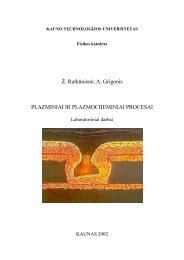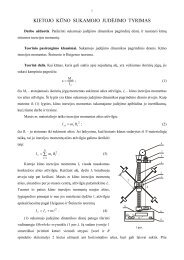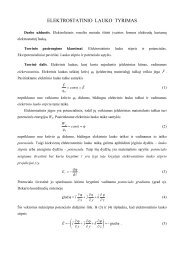PROCEEDINGS OF THE 7 INTERNATIONAL ... - Fizika
PROCEEDINGS OF THE 7 INTERNATIONAL ... - Fizika
PROCEEDINGS OF THE 7 INTERNATIONAL ... - Fizika
You also want an ePaper? Increase the reach of your titles
YUMPU automatically turns print PDFs into web optimized ePapers that Google loves.
MEDICAL PHYSICS IN <strong>THE</strong> BALTIC STATES 7 (2009)<br />
Proceedings of International Conference “Medical Physics 2009”<br />
8 - 10 October 2009, Kaunas, Lithuania<br />
TOTAL AND SCATTER DOSE MODELLING IN PHOTON IRRADIATED Si<br />
SAMPLES, COVERED BY PROTECTIVE COATINGS<br />
Inga CIBULSKAITĖ*, Diana ADLIENĖ*<br />
*Kaunas University of Technology<br />
Abstract: Total and scatter doses due 25-32 keV X-ray beam irradiation of Si samples, covered by different materials<br />
protective coatings, calculated by Monte Carlo based modelling code EGSnrc are presented in this paper.<br />
Keywords: dose, scatter, modelling, Monte Carlo<br />
1. Introduction<br />
Through low energy (25-32) keV X-ray photon<br />
interactions (the photoelectric effect, the Compton<br />
effect) with material, the photon radiation transfers<br />
energy to it. This transfer is considered as a dose.<br />
The energy transport during the X-ray photons<br />
interaction with different materials, that are used for<br />
radiation registration, processes could be analysed in<br />
detail experimentally or by modelling. In constructions<br />
of up-to-date detectors new perspective composite<br />
materials (crystal, polycrystalline) are used, the active<br />
volume of the most detectors is protected by protective<br />
coating (polymers, amorphous materials), defending it<br />
from mechanical, aggressive atmospheric and ionising<br />
radiation damage.<br />
It is difficult to test each construction practically, so the<br />
results obtained by mathematical modelling of the<br />
photon interaction process could be used for this<br />
purposes. and after this, by choosing the most<br />
perspective constructions – examine their characteristic<br />
practically.<br />
The scattered radiation, that is due to X-ray interaction<br />
with material, could reach the active volume again and<br />
that negatively influence on the registration of the useful<br />
signal.<br />
By varying detector‘s geometry, construction and<br />
materials composition according to selected criterion it<br />
is possible to find the optimal version for detector with<br />
less influence of scatter to the signal recorded by<br />
detector. The selection of such criterion let us<br />
prognosticate new constructions, to compare its<br />
characteristic to characteristics of detectors used in<br />
praxis. As the criterion for the scatter process estimation<br />
in radiation sensitive material could be calculated<br />
according to lower scatter dose to total dose ratio. By<br />
application of this criterion it is possible to compare<br />
indirectly the efficiency of the registration of all<br />
configurations detectors also those that are under<br />
construction.<br />
72<br />
Si is one of the materials sensitive to ionising radiation<br />
and applied in many solid state detectors. Not<br />
considering the detective properties of this material, the<br />
calculation of the total and scatter dose by Monte Carlo<br />
based code in Si samples, was done to investigate the<br />
influence of the different protective coatings applied to<br />
Si samples, for the doses results.<br />
2. Instruments and methods<br />
Interactions of low energy (25-32) keV polyenergetic<br />
X-ray photons with matter were simulated using<br />
simulation code based on Monte Carlo method (EGSnrc<br />
Code system) [1] Investigation of interaction effects in<br />
Si samples was performed using adapted the real<br />
exposure conditions, representing mammography<br />
examinations of patients.<br />
Assuming that Si sample without and with coating was<br />
placed at a central position on the top of 45 mm<br />
polymethylmethacrylate PMMA phantom, representing<br />
“standard” compressed female breast that was used<br />
instead of patient for the simulation of the real<br />
irradiation conditions, Monte Carlo simulations were<br />
performed within cylindrical geometry, virtually<br />
dividing the X-ray exposed space between compression<br />
paddle and breast support table into zones,<br />
corresponding to the different densities and<br />
compositions of presented materials.<br />
Individual photon histories were simulated and the<br />
history of each photon was followed until either all of<br />
its energy was transferred to electrons or it was<br />
absorbed locally due to the scattering events in material.<br />
It was assumed that 10 8 or 10 9 photons having in 1 keV<br />
increments increasing energy from the range of 1 keV to<br />
35 keV interact with samples. Considering small sample<br />
size (mm range) as compared to exposure area (12 x 18)<br />
cm, it was assumed that X-ray photons beam is parallel<br />
to Z-axis in the central zone of interaction and there was<br />
no X-ray beam distortion.<br />
Total and scattering doses in uncoated and coated<br />
samples were calculated using modified user code








